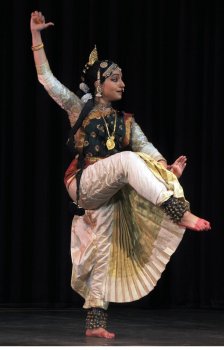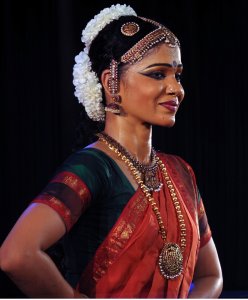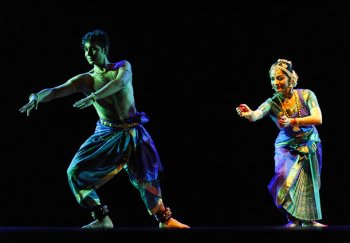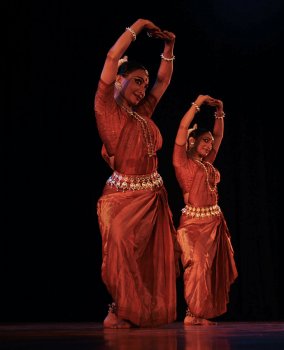
|   |

|   |
Music Academy Dance Festival: Day 7 - Veejay Sai e-mail: vs.veejaysai@gmail.com January 29, 2014 In the shadow of calamitous costumes The first performance of the last day of the Academy’s fest was a Kuchipudi solo recital by Prateeksha Kashi, the daughter and disciple of Vyjayanthi Kashi. The first thing that struck as Prateeksha walked onto the stage to open her performance, like a bolt from the blue, was her costume! What was she wearing? Was it supposed to be an innovation? An imitation? New found creativity that went haywire? Dressed like a character that would best suit a queen’s domestic governess with a flashy crown from a mythological film, she strutted onto the stage. She began her performance with an invocatory offering to goddess Balatripurasundari composed in ragam Abhogi and set to a talamalika by Vedantam Parvateesam. Describing the various divine facets of the goddess, as an embodiment of shodashakala, navarasa and the various abhinayam as described in the Natya Shastra, Prateeksha danced with much aplomb.  Prateeksha Kashi Photo: Thanthoni She continued into “Koluvai Unnade,” an excerpt describing Nataraja from the famous ‘Pallaki Seva Prabandhamu’ of Shaji Maharaj. The composition describes lord Nataraja in all his cosmic dancing glory. Prateeksha opened this piece with selections from stotras of Ravana, the great demonic devotee of Shiva and Jaimini. Utilizing syllables of the Maheshwar Sutras, some very excellent ideas of choreography came through, and all along one could see a highly excited Vyjayanthi participate with equal gusto on the side. A bit of the abhinayam went for a toss when Prateeksha had to show the “Aracheta oka jinka vaikhari” where she depicted a deer jumping around in a forest and “Paalukaaru moomuna” where she gestured the act of milking cows. For those who don’t understand the significance of why various ancient icons of Shiva hold a racing antelope in his upper hand is because of the larger metaphor associated with it. Several Agama scholars and historians of sculpture have subscribed to the idea that the antelope is a symbol for showing man’s unsteady mind, which darts to and fro like an antelope in the forest. Shiva’s iconography in some Sanskrit slokas describes him as “Parashu mrigavaraa deethi hastham” to denote the axe in one hand and antelope in another. While the axe is symbolic to the act of cutting out the darkness of ignorance, the antelope is symbolic to controlling the instable mind. Similarly the lines “Paalukaaru moomuna” in a direct reference is the act of giving abhishekam with milk to the statue of Shiva but the larger and deeper significance of this, Ananda Coomaraswamy writes, is to describe Shiva as the one with the most peaceful and serene face, in spite of his vigorous dance that he is simultaneously involved in. This philosophical juxtaposition is personified in the iconography of Shiva and expressed poetically through the composition. However, Prateeksha’s sancharis didn’t budge beyond the prosaic and obvious and hence the reference to milking cows. She continued her performance with an excerpt from the famous ‘Bhama Kalapam,’ the daruvu or act of describing Satyabhama’s famous jada or braid. “Veni vritaantamu” is an elaboration of the entire mythology and lore associated with the braid. Designed by Vishwakarma, the braid’s ornamentation signifies everything from the trinity of gods to planets and zodiacs to rishi mandalams and more subtle philosophies. It was this priceless braid that adorns the head of Bhama and gives lease to her own pride. In her performance, Prateeksha just went and patched on a braid to her already existing one and performed and as someone in the audience pointed out, it seemed to come across as rather tacky. In the next piece she presented an oft-repeated javali in both music concerts and dance recitals, “Nee maatalemaayenu raa” which had nothing to write home about. She concluded with a Tarangam, a signature item in the Kuchipudi repertoire. Set to ragam Amritavarshini, “Paahee Paahee” of the Andhra poet saint Narayana Teertha has been performed earlier by countless dancers. Even the spectacle of dancing on the edges of a brass plate wasn’t of any notable scale. Prateeksha has tons of talent and can be a big name in Kuchipudi at a time when the dance form itself is falling short of good dancers. What she needs is to put in a lot of hard work and perform with conviction. She wouldn’t need reasons such as a drastic costume overhaul to grab attention and will be talked about for her dance instead. Mature mosaics After that hectic first performance, it was a change of mood for the better to watch the recital of Navia Natarajan.  Navia Natarajan Photo: Thanthoni Navia began her performance with an invocation to the Devi as the embodiment of strength and courage. Taking verses from the Devi Navaratnamalika and Lalithopakhyanam, the music was smartly set by Debur Srivatsa to a ragamalika and a talamalika. The sounds of edakka set the whole piece into an esoteric mood to celebrate the glory of the divine feminine. Navia’s next piece was the famous Tanjore Quartet masterpiece “Sakhiye inda velayil” in ragam Ananda Bhairavi set to adi talam. She took the whole composition with a lot of repose and patiently worked her way through it. One also got to enjoy the elaboration of the ragam in the beautiful violin played by Easwar Ramakrishnan and Mahesh Swamy’s melodious flute. While some of the jathis did tend to stretch a bit, none of it was overtly done as to mar the flow of the composition or its mood. In sancharis where she depicted the various leelas of Krishna including lifting the Govardhana mountain, coming to the rescue of Draupadi at the time of Vastrapaharanam and so on, Navia displayed a subtle maturity in her presentation. Completely different nayika was in disposition in the next piece as Navia danced to “Yenganum vara vara” composed by poet Kavi Kunjara Bharati. A nayika chiding lord Subramanya for going to the other woman and returning bereft of all his paraphernalia was the plot of this padam. With her expressive eyes and facial gestures, Navia was in the best of her element. She concluded her performance with a thillana composed by Maharaja Swati Thirunal set to ragam Bhupalam. Navia has matured in so many levels when it comes to her dance. Her abhinayam has gotten better from the previous years’ performances in the season and one can see she has put in a lot of hard work and attempted genuinely in reaching new depths of substance in her art. Chemistry of the soul The most prized slot of the Music Academy’s dance festival after the opening evening is the last day’s evening slot. It also heralds the conclusion of the week-long international festival and being in its exalted position, demands a full hall for audience. This year, this slot was given to the stage cum real life dancer couple Shijith Nambiar and Parvathy Menon, both products of the hallowed Kalakshetra bani of Bharatanatyam. The evening opened with a fantastic concert by Arun Gopinath singing “Giriraja suta tanaya sadaya,” a composition of saint Tyagaraja set to ragam Bangala. Arun has improved a lot from the last few years, especially in his pronunciation of sahityam and is capable of giving full concerts. Easwar Ramakrishnan added his magic violin to Arun singing and enhanced that experience for all of us. Shijith and Parvathy began with an invocatory piece to lord Nataraja. Using verses from Kunchithaangristhavam by Umapathi Sivam and merging that into “Jalandhara,” a composition of Jayachamaraja Wodeyar, the erstwhile ruler of the Mysore state to the spine of which they smartly fixed an alarippu set to Sankeernam and Mishram by Karaikudi Krishnamurthy. While this idea to knit all this was fantastic and worked at a literary level, the visual references seemed direct. Displaying direct word to word of the iconography seemed to bring it down in its over-arching effect.  Shijith Nambiar and Parvathy Menon Photo: Siddharth Chandrasekar The couple’s artistic chemistry blossomed forth in the Swathi Thirunal varnam “Sarasa sara sundara” set to ragam Neelambari. Arun Gopinath’s voice and Easwar’s violin were to make a strong comeback in the highly evocative aalapam they preluded to the varnam. With jathis by Karaikudi Krishnamurty effectively rendered by Gireesh Madhu, the couple danced in buoyant abandon displaying their ease and joie de vivre. Describing stories of lord Padmanabha, who in all his reclining grandeur guards the city of Thiruvananthapuram, Shijith and Parvathy gave us the various narrations in their choreography. Gajendramoksham, Draupadi Vastrapaharanam, Dashaavataram and other such tales from Vishnu mythology took on an interesting colour and mood in their interpretation. This sort of artistry is achieved by couple-dancers who know smart choreography without overdoing the dramatic element. Mahesh Swamy’s flute and Anantanarayanan’s veena added further in enhancing the orchestration of a sensuous ragam like Neelambari. For those of us who looked at the Academy brochures, we were excited that the couple was going to perform the ashtapadi “Sakhi hey.” It was a bit of a disappointment to know they had cancelled it and replaced it with another piece. The next piece they performed was titled ‘Punah samaagamam.’ Set to a Surdas bhajan “Tumse kahaan se kaho” set to a ragamalika and talamalika by Bombay Jayashree, the plot was that of a distraught Radha who has come to complain to Krishna how she has become the topic of gossip among the women of Braj. This tantrum, because Krishna held her hands in public to display his intimacy. Shijith as Krishna and Parvathy as Radha fit perfectly in their roles for this composition. One could sense a little bit of struggle in Arun’s singing as he waded through the ragamalika but the concluding act fell in place with the dance. While most of the choreography for this composition seemed directly borrowed from the larger canvass of Bharatanatyam’s movements, further reworking this piece would help the couple in elevating it into a more interpretative one. Shijith and Parvathy attempted it with much honesty and that hard work did come through. They concluded their performance with a simple but elegant Mangalam and cut short the thillana due to time constraint; a lesson other dancers and groups could take from who eat into the next performer’s time without any regard. Shijith and Parvathy are excellent as dancers and work like magic as a performing couple. Without eating into each other’s space and artistic deportment, theirs is a chemistry that emerges from putting their soul into their art. We hope they continue on the same note in the long run! Slowly swung the song The grand finale of the Academy’s festival, like last year, was the Nrityagram group from Bangalore. Last year they swept the audiences into awe with their collaboration with the Kandiyan dancers from the Chitrasena dance school in Sri Lanka. Everyone waited for the grand finale dhamaka Nrityagram was to give.  Nrityagram Photo: Siddharth Chandrasekar The first piece performed by Bijayini Satpathy and Pavithra Reddy was an invocation to Devi with music set by the late Pt Raghunath Panigrahi. Looking like sculptures in their poses and slow movements, they looked like apsaras from a different world. In the choreography, which involved giving aarathi to the goddess, it was a sight to see Bijayini in full glory as Devi as Pavithra circumambulated her with a real lamp. As the chants of “Ya Devi sarva bhooteshu” went into the air and every one of us sat enraptured, a major technical snag got the show to a grinding halt. A total blackout on the stage and the audience in commotion! Who would have expected this at the Music Academy?! However, that was sorted out and they were back on the stage to continue where they stopped. In no time we forgot the technical glitch and were carried away into their world. As recitations of “Kamaladalamama komala kanti” rang in the air, multiple rounds of applause were heard. One can’t deny the exceptional lighting design by Lynne Fernandez, easily one of India’s top seasoned experts in that area. In the next piece, an ode to spring season, the same dancers were seen in a contrasting light. With music by the late Pt Raghunath Panigrahi set to jathi taal, one could see the various abstractions of the spring season contained in Bijayini’s performance. A strong usage of the Samm in madhyam was noteworthy. In the third piece was a solo by Pavithra Reddy who performed a Surdas bhajan “Sun maiyyan.” A bit low on energy, this piece didn’t fall into place. Added to this was the jarring effect of the violin and even the singer Jateen Sahu seemed highly stressed out in his rendering, which was visible to all of us sitting in the audience. A strong deficiency of flute music was felt in this composition and its current music presentation. The last piece for the evening was an excerpt from the Ramacharitmanas by Tulsidas. This piece was one of the signature pieces often performed by their guru, the gorgeous Protima Gauri. The long solo by Bijayini had elements of brilliance when she depicted Maricha the golden deer, the episode of Sita’s abduction by Ravana and Rama’s act of kindness to Jatayu. However, it fell short of the vital energy, which is always so evident in their performances. The show at the Academy also felt the strong absence of Surupa Sen on the stage. Having hurt her leg, she stayed away from the show. It might be this or it might have been the selection of pieces for the whole performance, somehow it didn’t seem to gel together like it always does. Compared to all the earlier Nrityagram shows, this was a very low key affair. We hope Surupa’s leg heals soon enough and we have her back on the stage with all the exuberance and dynamism she brings to their shows. Nrityagram artistes are some of the truly international performers we have in India and one can be assured they will return with a bang! Veejay Sai is a writer, editor and a culture critic. He is the official reviewer for the Madras Music Academy’s annual dance festival. |